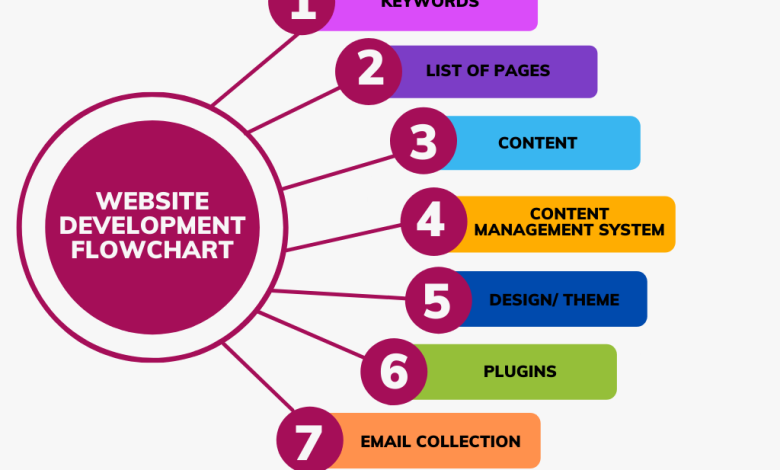
The website development process can be a confusing and intimidating experience, but it doesn’t have to be. Just like any other project, there are steps you will need to follow in order for your new website to be successful.
Read also: The website development courses in Chandigarh and its 8 Biggest Trends
In this guide, we’ll walk you through each step of the process so that when your site launches. You’ll have all the information needed to know exactly what went right or wrong along the way.
Complete Step-by-Step Guide To The Website Development Process
Are you thinking about getting a website developed for your business? If so, you’re probably wondering what the process is like.
At its most basic, the website development process involves four steps: planning, design, development, and deployment. Of course, there’s a lot more to it than that.
In this article, we’ll take a closer look at each of these steps and what you can expect during the website development process.
- Planning
- Design
- Development
- Testing
- Launch
Step 1: Project planning
The first step in any website development project is planning. This is where you’ll determine your website’s goals, target audience, and content.
You’ll also need to decide on a domain name and hosting provider. Once you have all of this information, you’ll be able to start putting together a website development plan.
- Project planning is the first step in the website development process. It’s important to think through all of your needs and requirements before you start working on your site.
- This will help ensure that you have a clear idea of what needs to be done, how long it’ll take, and when it should be finished by.
- To get started with project planning.
- Identify what kind of website design or development services are needed for each client’s business objectives.
- Determine if there are any existing websites that could serve as inspiration for your own project.
Step 2: Gather your content
The second step in the process is to gather content. Content is king and a key part of the user experience. It’s also important for SEO because it helps search engines determine what type of content they should rank, which means higher rankings for your site.
There are many ways to gather this information:
- Conduct research on your competitors’ websites.
- Talk with customers or prospects who would use your product or service, asking them questions about their needs and goals.
Step 3: Design
Design is the most important part of any website. It’s what people see, and remember and how you communicate your brand. The design process should start with a focus on user experience (UX), rather than just looking at aesthetics or functionality.
If you’re not sure what UX is, it means how users interact with your product or service. The way they navigate around it, how they find what they’re looking for, and so on.
A good example is Google Maps: when we enter an address into our browser window, Google matches it up against maps stored in its database before displaying a list of businesses near where we are located based on their locations relative to yours.
Step 4: Development
The fourth step in the process is developed, which can be broken down into two phases: front-end and back-end. Front-end refers to the user interface of your site, including its layout and design; back-end refers to functionality such as databases and code running on your site.
If you’re not a programmer, you’ll need to hire a web developer to create your website for you. Once the website is complete, you’ll be able to test it to make sure everything is working correctly.
Front-End
The front end includes everything you see when someone visits your website or app. The pages themselves (HTML5), images for backgrounds, videos for videos embedded within posts or pages, etc.
Step 5: SEO, analytics, and other tools
SEO, search engine optimization, is the process of improving your site’s visibility in search engines. The goal is to make sure that when people search for keywords relevant to your business, they’ll find you first. This can be done by optimizing content so that it ranks higher on Google and other major search engines.
Analytics are tools used by web developers and marketers alike to track how users interact with websites. Analytics allows them to understand what parts of their sites work best and where improvements need to be made so they don’t waste time trying out new features before finding out whether they’re actually getting traffic from them!
Step 6: Launch
Once you have the new website up and running, it’s time to start marketing. Your first step should be a launch party. This will give your team an opportunity to celebrate their hard work in getting the site launched, as well as let clients get a chance to see how great their new site looks!
Once the party is over, send out press releases about what happened at the event and how much fun everyone had at each table. You can also set up social media accounts for each client so that they can share photos with friends and family who missed out on attending.
Hire A Web Design Company Dubai
So you’ve decided that you need a website. Good decision! It’s one of the easiest ways to get your business noticed and increase sales, but there are some things to keep in mind before hiring a designer or developer.
When it comes to hiring a designer or developer, it’s important to remember that they will have their own ideas on how best fit their expertise into your business needs. If this is something that doesn’t match up with what works for you, then they might not be able to pull off the project successfully.
Your website development process will be different from the next person’s, but this guide can help you get started.
This guide is a step-by-step process that will help you build your website. It’s not the only way to do it, but it is an option for people who want to take control of their own projects and create something unique.
This guide isn’t meant for people who have no idea what they’re doing or how much time and money they should budget for the job. If you’re looking for someone else’s advice on how much money should be spent on building out your site, start here.
There are a few things to keep in mind when launching your website. First, make sure you announce your launch date in advance so people can start spreading the word. Second, create a plan for promoting your website once it’s live. And third, don’t forget to measure your website’s performance so you can continue to improve it over time. We hope this overview of the website development process has been helpful. If you have any questions, feel free to contact us and we’ll be happy to help.
Conclusion
As you can see, there are many aspects to website development. The process is not always linear and will differ from person to person. However, by following these steps and keeping track of your progress in a project management tool such as Trello or Asana, you’ll be able to stay on top of the process and make sure that everything is running smoothly when it comes time for launch.






